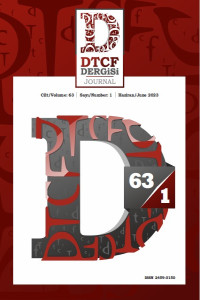Abstract
One of the most important reasons for the Ottoman Empire to lose its Balkan lands is the nationalism movement that arised its effect in the 19th century. This national consciousness, which causes Bulgaria to become an independent state, is realized through written texts. In these written texts, it was reminded that the Bulgarian people should not forget their identities and a negative attitude towards the Ottomans and Turks. The negative Turkish image, which was revealed by the contributions of the clergy, called on the Bulgarian people to revolt. With the establishment Principality of Bulgaria, this negative image has diminished its influence in literary works but continued systematically. These writers, including Nikolay Haytov, made great efforts to not to forget this hostility to the Turks. Some of these texts, which contain negative expressions about Turks, have been filmed or adapted to the theater in order to reach the masses. In this context, the story of Nikolay Haytov titled “Goat Horn” in his book “Wild Stories” brought a great deal of attention among the Bulgarian literature and was shown twice on the screen. This negative Turkish image in the work is of great importance for Bulgarian people. In this story which is one of the most important book, this negative Turkish image will be examined in our study.
References
- Haytov, N. (1972). Dünya Poturunu Çıkarıyor. (N. Yılmaer, Çev.). Ankara: Bilgi Yayınevi.
- Haytov, N. (2002). Patikalar. (İ. B. Ağlagül, Çev.). Ankara: Kültür ve Turizm Bakanlığı Yayınları.
- Haytov, N. (2017). Divi razkazi. Sofiya: Pamet.
- İgov, S. (1996). Kratka istoriya na bılgarskata literatura. Sofiya: Prosveta.
- Kamenova, E. (2007). Byatırnite melnitsi. Statii, studii, retsenzii. Plovdiv: İzdatelska kıshta Hermes.
- Mevsim, H. (2007). Bulgar Öykücülüğü Tarihine Genel Bir Bakış. Eşik Cini, 7, 62-79.
- Özel, A. (1996). Sipahi. İslâm Ansiklopedisi (C. 13, s. 418-427). İstanbul: Türkiye Diyanet Vakfı Yayınları.
- Pars, M. (2008). Serdar: Grigor Pırliçev İnceleme. Ankara: Kül-Sanat.
- Shimko, İ. (2015). Chovek i priroda: Divoto v sıchineniyata na Emilyan Stanev i Nikolay Haytov. Wien: University of Wien.
- Tsanev, G. (1982). Reçnik na bılgarskata literatura, Tom 3. Sofya: İzdatelstvo na BAN, (s. 519-522).
- Zaharieva, L. (2015). Nikolay Haytov: Sreshti i razgovori, analizi, pisma. Chast 1. Montana: Polimona.
- Hristov, İ. (2019). Prof. İvaylo Hristov: Nikolay Haytov be mıj s misiya- ne se izkushi da izlıje, ne se predade! Erişim Tarihi: 01.01.2023, https://epicenter.bg/article/Prof--Ivaylo-Hristov-/192657/11/0
- Paunovich, S. (2004). Iz pesnik planine shume i sela. Erişim Tarihi: 01.03.2023, https://liternet.bg/publish6/spaunovich/pesnik.htm
- Velkova-Gaydarjieva, A. (2001). Za ritualnite smisli na choveshkoto bitie. Erişim Tarihi: 10.10.2022, https://liternet.bg/publish2/avelkova/haitov.htm
- Yanev, V. (2006). “Divi Razkazi” v Bılgarskata literaturna kritika. Erişim Tarihi: 23.02.2022, https://liternet.bg/publish13/v_ianev/divi.htm
Abstract
Osmanlı Devletinin Balkan topraklarını kaybetmesindeki en önemli nedenlerden biri de 19. yüzyılda etkisini gösteren milliyetçilik akımıdır. Bulgaristan’ın bağımsız bir devlet olmasına neden olan bu ulusal bilinç, yazılı metinler sayesinde gerçekleşir. Bu yazılı metinlerde Bulgar halkına kimliklerini unutmamaları gerektiği hatırlatılırken Osmanlı ve Türklere karşı da olumsuz bir tutum sergilenmiştir. Din adamlarının da katkılarıyla ortaya çıkarılan olumsuz Türk imgesi Bulgar halkını ayaklanmaya çağırmıştır. Bulgar Prensliğinin kurulması ile bu olumsuz imge edebi eserlerde etkisini azaltmış ancak sistemli olarak devam etmiştir. Nikolay Haytov’un da aralarında bulunduğu bu edebiyatçılar Türklere olan bu düşmanlığın unutulmaması için büyük çaba sarf etmişlerdir. Türklerle ilgili olumsuz ifadelerin yer aldığı bu metinlerden bazıları, geniş kitlelere ulaştırılması için beyaz perdeye aktarılmış ya da tiyatroya uyarlanmıştır. Nikolay Haytov’un “Yaban Öyküleri” kitabında yer alan “Keçi Boynuzu” başlıklı öyküsü bu bağlamda Bulgar edebiyatında büyük ses getirmiş ve iki kez beyaz perdede sergilenmiştir. Eserde yer alan bu olumsuz Türk imgesi Bulgar halkı için büyük önem taşımıştır. Çalışmamızda Nikolay Haytov’un en önemli eserlerinden biri olan “Keçi Boynuzu” öyküsündeki olumsuz Türk imgesi incelenecektir.
References
- Haytov, N. (1972). Dünya Poturunu Çıkarıyor. (N. Yılmaer, Çev.). Ankara: Bilgi Yayınevi.
- Haytov, N. (2002). Patikalar. (İ. B. Ağlagül, Çev.). Ankara: Kültür ve Turizm Bakanlığı Yayınları.
- Haytov, N. (2017). Divi razkazi. Sofiya: Pamet.
- İgov, S. (1996). Kratka istoriya na bılgarskata literatura. Sofiya: Prosveta.
- Kamenova, E. (2007). Byatırnite melnitsi. Statii, studii, retsenzii. Plovdiv: İzdatelska kıshta Hermes.
- Mevsim, H. (2007). Bulgar Öykücülüğü Tarihine Genel Bir Bakış. Eşik Cini, 7, 62-79.
- Özel, A. (1996). Sipahi. İslâm Ansiklopedisi (C. 13, s. 418-427). İstanbul: Türkiye Diyanet Vakfı Yayınları.
- Pars, M. (2008). Serdar: Grigor Pırliçev İnceleme. Ankara: Kül-Sanat.
- Shimko, İ. (2015). Chovek i priroda: Divoto v sıchineniyata na Emilyan Stanev i Nikolay Haytov. Wien: University of Wien.
- Tsanev, G. (1982). Reçnik na bılgarskata literatura, Tom 3. Sofya: İzdatelstvo na BAN, (s. 519-522).
- Zaharieva, L. (2015). Nikolay Haytov: Sreshti i razgovori, analizi, pisma. Chast 1. Montana: Polimona.
- Hristov, İ. (2019). Prof. İvaylo Hristov: Nikolay Haytov be mıj s misiya- ne se izkushi da izlıje, ne se predade! Erişim Tarihi: 01.01.2023, https://epicenter.bg/article/Prof--Ivaylo-Hristov-/192657/11/0
- Paunovich, S. (2004). Iz pesnik planine shume i sela. Erişim Tarihi: 01.03.2023, https://liternet.bg/publish6/spaunovich/pesnik.htm
- Velkova-Gaydarjieva, A. (2001). Za ritualnite smisli na choveshkoto bitie. Erişim Tarihi: 10.10.2022, https://liternet.bg/publish2/avelkova/haitov.htm
- Yanev, V. (2006). “Divi Razkazi” v Bılgarskata literaturna kritika. Erişim Tarihi: 23.02.2022, https://liternet.bg/publish13/v_ianev/divi.htm
Details
| Primary Language | Turkish |
|---|---|
| Subjects | Creative Arts and Writing |
| Journal Section | Research Article |
| Authors | |
| Early Pub Date | June 10, 2023 |
| Publication Date | June 20, 2023 |
| Submission Date | March 30, 2023 |
| Published in Issue | Year 2023 Volume: 63 Issue: 1 |
Ankara University Journal of the Faculty of Languages and History-Geography is licensed under Creative Commons Attribution 4.0 International (CC BY 4.0).


